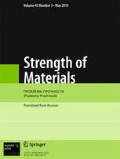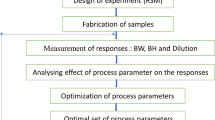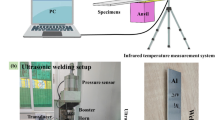The cold roll bonding process of a laminar metal composite consists of three steps, i.e., surface treatment, cold roll bonding, and heat treatment. The surface pretreatment is the precondition of obtaining a metal composite with a superior bonding level. The influence of the steel plate surface condition on the bonding strength is studied, based on the bonding mechanism of a laminar metal composite by cold roll bonding. Flap disc grinding is a better surface treatment than wire brushing for obtaining high bonding strength. Within a certain range, the larger the surface roughness, the higher the bonding strength. Comparing different grinding textures, viz longitudinal, transverse, and 45° with respect to the rolling direction, it was revealed that the longitudinal surface texture was more advantageous for bonding.







Similar content being viewed by others
References
D. Pan, K. Gao, and J. Yu, “Cold roll bonding of bimetallic sheets and strips,” Mater. Sci. Technol., 5, 934–939 (1989).
H. Y. Wu, S. Lee, and J.Y. Wang, “Solid state bonding of iron-base alloy, steel-brass and aluminum alloy,” J. Mater. Process. Technol., 75, 173–179 (1998).
V. Y. Mehr, M. R. Toroghinejad, and A. Rezaeian, “The effects of oxide film and annealing treatment on the bond strength of Al–Cu strips in cold roll bonding process,” Mater. Design, 53, 174–181 (2014).
L. R. Vaidyanath and D. R. Milner, “Significance of surface preparation in cold pressure welding of metals,” Br. Weld. J., 7, 1–6 (1960).
H. A. Mohamed and J. Washburn, “Mechanism of solid state pressure welding,” Weld. J., 54, 302–310 (1975).
R. Jamaati and M. R. Toroghinejad, “Cold roll bonding bond strengths: review,” Mater. Sci. Technol., 27, 1101–1108 (2011).
Acknowledgments
The present study was financed by the National High-Tech Research and Development Program (2013AA031301) and Chinese National-International Scientific and Technological Cooperation Project (2013DFB50170). The authors would like to thank the University of Science & Technology Beijing (USTB) for providing rolling mill and materials used in this work.
Author information
Authors and Affiliations
Corresponding author
Additional information
Translated from Problemy Prochnosti, No. 1, pp. 172 – 178, January – February, 2015.
Rights and permissions
About this article
Cite this article
Tang, C., Liu, Z., Zhou, D. et al. Surface Treatment with the Cold Roll Bonding Process for an Aluminum Alloy and Mild Steel. Strength Mater 47, 150–155 (2015). https://doi.org/10.1007/s11223-015-9641-3
Received:
Published:
Issue Date:
DOI: https://doi.org/10.1007/s11223-015-9641-3




